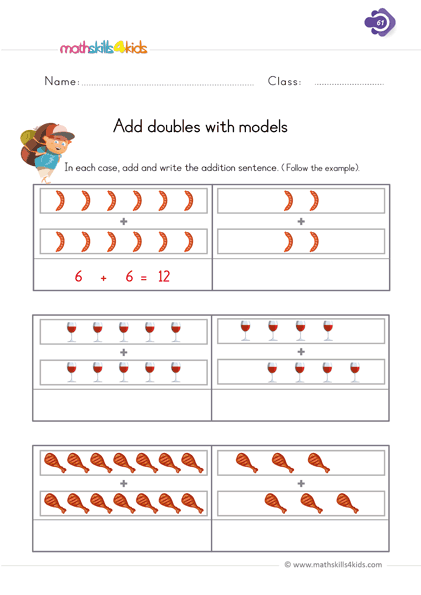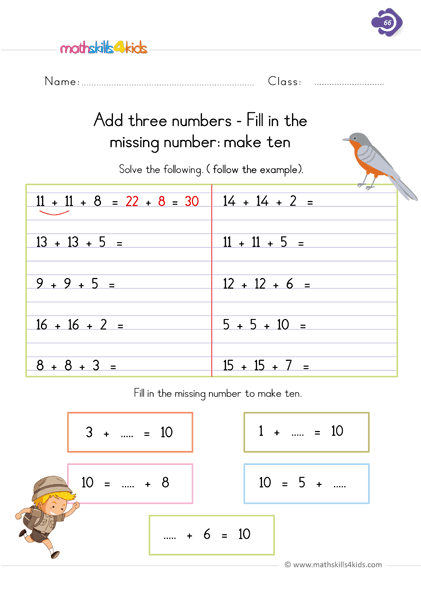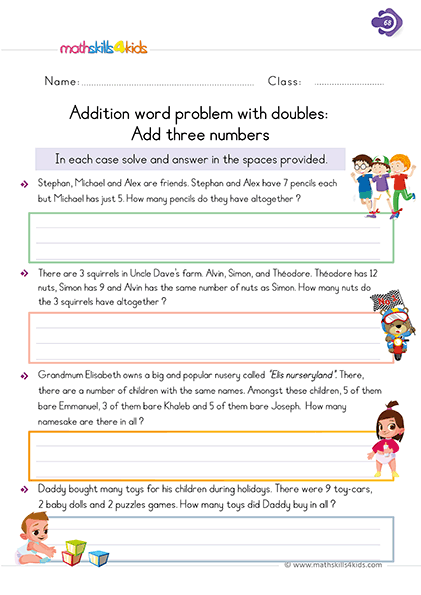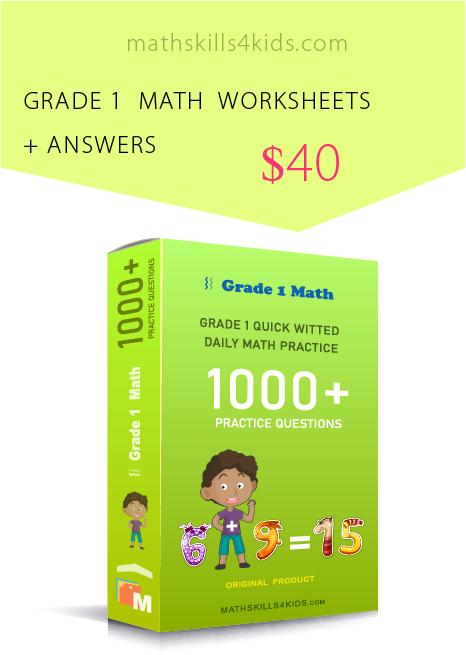Mastering addition facts: 1st Grade worksheets and strategies
Are you looking for ways to help your first grader master addition facts? Do you want to make math fun and engaging for your child? If so, you've come to the right place!
In this resource, we have produced the best addition facts worksheets for 1st graders to practice and memorize basic addition facts using different strategies. Also, you'll learn and understand why addition facts matter for 1st graders and how to teach them the concept of addition.
-
It is important to note that these fun and engaging worksheets from Mathskills4kids consist of fun tips and tricks that will help your 1st graders learn addition facts easily as well as apply their skills to real-life situations.
In addition, you'll discover some fantastic resources and games to reinforce their learning and make math a blast!
Let's get started!
Why addition facts matter for 1st graders
Have you ever wondered why addition facts matter for 1st graders? Certainly No!
First, addition facts are the building blocks of math. They are the basic sums of single-digit numbers, such as 2 + 3 = 5 or 7 + 8 = 15. By mastering addition facts, your child will develop a strong foundation for more advanced math skills, such as subtraction, multiplication, division, fractions, decimals, and more.
Secondly, mastering addition facts will boost your child's confidence and motivation in math. They can solve problems faster and more accurately, making them feel proud and accomplished. They will also enjoy math more and have a positive attitude toward learning new concepts.
Also, mastering addition facts will prepare your child for standardized tests and academic success. Many tests require quick recall of basic math facts, affecting your child's score and performance. Hence, knowing their addition facts by heart, your child can answer questions more efficiently and avoid mistakes.
-
BROWSE THE WEBSITE
-
DOWNLOAD FREE WORKSHEETS
-
-
1st GRADE MATH TOPICS
- Counting and numbers
- Understand addition
- Addition skills
- Addition exercises
- Addition strategies
- Understand subtraction
- Subtraction skills
- Subtraction Exercises
- Subtraction strategies
- Mixed operation
- Comparing numbers up to 100
- Estimation Worksheets
- Place value
- Spatial sense
- Graphing & data
- Measurement
- Patterns
- Probability
- Sorting & classifying
- Telling time
- 2D shapes
- 3D shapes - Solids figures
- Fractions
-
-
Understanding the concept of addition
Before your child can memorize addition facts, they need to understand the concept of addition and how it works. Addition is combining two or more groups of objects or numbers to get a total amount. For example, if you have 3 apples and 4 oranges, add them together to get 7 fruits.
To help your child understand the concept of addition, you can use concrete objects or manipulatives, such as counters, blocks, beads, or coins. You can also use pictures or drawings to represent the objects or numbers. For example;
You can show your child how to add 2 + 3 using counters or dots: o o + o o o = o o o o o
You can also use stories or word problems to introduce the concept of addition. For example, you can say:
"Anna has 2 dolls, and Ben has 3 dolls. How many dolls do they have together?" You can then use objects or pictures to model the problem and find the answer.
-
Memorizing basic addition facts
Once your child understands the concept of addition, they can start memorizing basic addition facts. Memorizing basic addition facts is an essential skill for first graders to master.
One effective strategy is to use flashcards with addition facts written on them. Start with the more accessible facts, such as 0+1 or 1+1, and gradually work up to more difficult ones.
Another strategy is to use games and activities to make learning fun, such as playing addition bingo or using a number line to practice adding. With consistent practice and patience, your child will soon be able to recall addition facts quickly and accurately.
Here are some examples of how to teach addition facts using different strategies:
-
How to teach addition facts using different strategies
One of the best ways to teach addition facts is to use strategies that appeal to different learning styles. Some of the most common strategies are:
Counting on: This is when you start with one number and count up to find the sum. For example, to add 3 + 4, start with 3 and count on 4 more: 3, 4, 5, 6, 7.
This strategy is suitable for beginners who are still learning the number sequence.
Making ten: This is when you use the fact that 10 is a friendly number that can be easily split into two parts. For example, to add 8 + 5, you can make a ten by taking 2 from 5 and adding it to 8. Then you have 10 + 3, which is easier to add.
This strategy is suitable for developing number sense and mental math skills.
Using doubles: This is when you use the fact that adding two equal numbers is easy to remember. For example, to add 6 + 6, you just double 6 and get 12.
This strategy is suitable for building fluency and recall of basic facts.
Using doubles plus or minus one: This is when you use the fact that adding or subtracting one from a double is also easy. For example, to add 7 + 8, you can use the double of 7 (14) and add one more.
Or, to add 9 + 8, you can use the double of 8 (16) and subtract one. This strategy is suitable for extending the knowledge of doubles to near-doubles.
Adding three numbers: This is when you use the fact that adding three numbers can be done by grouping two numbers first and then adding the third. For example, to add 4 + 5 + 6, you can group 4 and 6 first (because they make a ten) and then add 5.
Or you can group 5 and 5 first (because they are double) and then add 4. This strategy is suitable for developing flexibility and efficiency in adding.
-
Fun and engaging worksheets to practice addition facts
One of the best ways to practice addition facts is to use fun and engaging worksheets that reinforce the different strategies. Here are some examples of worksheets that you can use with your child:
- Adding Doubles with Models: This worksheet helps your child practice adding doubles using pictures of objects or dots. For example, to add 4 + 4, your child can count the dots in each group and write the sum.
- Adding Doubles: Find the Missing Number: This worksheet helps your child practice adding doubles using equations with a missing number. For example, to solve __ + __ = 12, your child can think of a double that equals 12 (such as 6 + 6) and write it in the blanks.
- Add Using Doubles Plus or Minus One: This worksheet helps your child practice adding doubles plus or minus one using equations with missing numbers. For example, To solve __ + __ = 15, your child can think of a double close to 15 (such as 7 + 7) and then adjust it by adding or subtracting one.
- Adding Three Numbers using Doubles: This worksheet helps your child practice adding three numbers using doubles as a strategy. For example, to add 3 + 4 + 4, your child can use the double of 4 (8) and add 3 more.
- Addition Word Problems with Doubles: Add Three Numbers: This worksheet helps your child practice adding three numbers using word problems that involve doubles as a strategy. For example, To solve "Anna has four apples. She gives two apples to Ben. How many apples does Anna have now?", your child can subtract the double of two (4) from four.
-
Tips and tricks to help your child master addition facts
Here are some tips and tricks that you can use to help your child master addition facts:
Use flashcards: Flashcards are a great way to review and memorize addition facts. You can make your own flashcards using index cards or paper or buy ready-made ones from a store or online.
You can also use online flashcards or apps with interactive features and games.
- Play games: Games are a great way to make math fun and engaging for your child. You can play games that involve dice, cards, dominoes, bingo, puzzles, board games, etc.
You can also play online games or apps with different levels and challenges.
Sing songs: Songs are a great way to help your child remember addition facts through music and rhythm. You can sing songs with catchy tunes and lyrics that repeat the facts.
You can also make up your own songs using familiar melodies or rhymes.
Read books: Books are a great way to expose your child to addition facts through stories and illustrations. You can read books with math themes or concepts, such as counting, adding, comparing, etc.
You can also read books with math problems or puzzles your child can solve along with the characters.
Use manipulatives: Manipulatives are physical objects your child can touch and move around to represent math concepts. You can use manipulatives such as counters, blocks, beads, coins, etc.
You can also use everyday objects such as buttons, shells, rocks, etc.
How to apply addition skills to real-life situations
One of the best ways to help your child understand the importance and relevance of addition skills is to apply them to real-life situations. Here are some examples of how you can do that:
- Shopping: You can help your child practice adding by letting them help you with shopping tasks such as making a list, checking prices, comparing items, calculating totals, paying bills, etc.
- Cooking: You can help your child practice adding by letting them help you with cooking tasks such as measuring ingredients, following recipes, doubling or halving portions, setting timers, etc.
- Traveling: You can help your child practice adding by letting them help you with traveling tasks such as planning trips, packing bags, checking distances, estimating time, budgeting money, etc.
Resources and games to reinforce addition facts learning
If you are looking for more resources and games to reinforce addition facts learning for your child,
here are some suggestions:
- Grade 1 Addition Worksheets - free & printable | K5 Learning: This web page offers a variety of worksheets for practicing addition within 0-20, using pictures, number lines, number bonds, doubles, missing addends, whole tens and columns. It also includes some word problems and exercises for mental addition. The worksheets are free and printable
- IXL | Adding 1 | 1st grade math: This web page provides an interactive online practice for adding 1 to a number within 0-10. The students can answer multiple-choice questions and get immediate feedback. The web page also tracks the students’ progress and awards them with virtual prizes
- Browse Printable 1st Grade Addition Worksheets | Education.com: This web page features a collection of printable worksheets for first grade addition, covering topics such as word problems, fact families, drawing, adding with dice and dominoes, adding within 100 and more. The worksheets are colorful and engaging, and can be downloaded for free with a membership
Thank you for sharing the links of MathSkills4Kids.com with your loved ones. Your choice is greatly appreciated.
We hope this article has given you some valuable ideas on how to help your first-grader master addition facts!
Happy adding!
-





